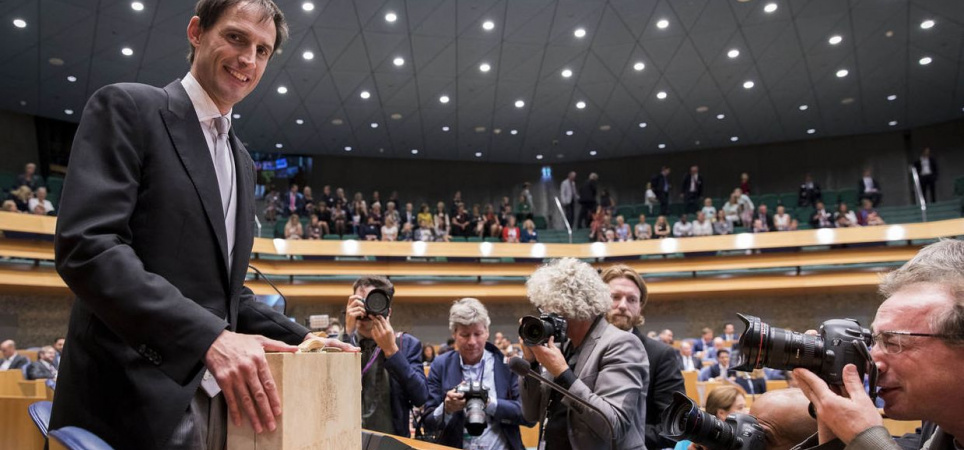Budget Day 2018: new setbacks for education
While education was hoping for new, extra investments, Prinsjesdag mainly had unexpected setbacks in store. From 2020 there is a new deficit of 114 million euros in the books. Education is not benefiting from economic growth.

Image: Valerie Kuypers / National Government
The new setback is related to the number of pupils and students, which is higher than previously estimated. In total, this involves an amount that rises to 160 million euros structurally. It is not until the spring memorandum that it is considered how the cutbacks will be implemented.
To cover the costs for 2019, the government is cutting more than 19 million euros extra on funding for higher education and another 19 million euros on practical training in MBO.
The latter subsidy is intended for employers who offer apprenticeships to BBL students who follow the vocational training pathway. This concerns, for example, welders, carpenters or cooks, who often follow their training in practice. The employers receive an allowance to enable students to learn the trade in their companies. The maximum amount that employers can receive in subsidy will be reduced from EUR 2700 per workplace to EUR 2500 in 2019.
The setbacks are partly related to the number of pupils and students, which is higher than previously estimated
Discount
These cuts are in addition to the so-called 'efficiency discount' of 92 million euros in 2019, which was already known. In the following years, that amount of savings will increase to 183 million euros. From 2020, a new deficit of 114 million euros is looming, which will increase to 160 million euros in 2022. That gap still has to be filled by the cabinet next spring.
The investments that will come out of the closet in 2019, on the other hand, are no surprise: they stem from the coalition agreement of a year ago. This includes 270 million euros for teacher salaries and 237 million for reducing the workload in primary education. It was also known that the cabinet will allocate 130 million euros for pre-school and early childhood education and 70 million for technical pre-vocational secondary education.
Analysis: Education investment further behind economic growth
The economy is growing, but education is not benefiting from it. An analysis of education expenditure on Budget Day.
Yes, education money will certainly be added. Hundreds of millions. For primary education salaries, for workload, for pre-school. But those hundreds of millions are less than you might expect on the basis of economic growth, according to the macroeconomic surveys of the Central Planning Bureau (CPB). Education is in the minus.
The percentage of our wealth that goes to education is steadily falling. From 5,2 percent in 2016 to 5,0 percent in 2019. And that while the need is great. Salaries are too low to compete with other sectors. Shortages are the order of the day in primary and special education, in secondary education and senior secondary vocational education in some subjects. After the zero line of the crisis years, steps are taken now and then, but the real catch-up is not forthcoming.
Money box
And that's not all. The Ministry of Education is faced with a so-called estimation problem. In the past, pupil and student numbers were invariably overestimated, which allowed education to build up a piggy bank for setbacks. That budget machinery has been adjusted. Nowadays there are permanent setbacks, because there are more pupils and students than estimated.
In this way, the 'hole of Bussemaker' has arisen, a cut that, as an 'efficiency discount', will result in a cut of 92 million euros in 2019, which will increase to 183 million euros in a few years. The education budget now also shows a 'gap of Van Engelshoven' on Prinsjesdag. Some of the setbacks will be solved with money from all kinds of pots, but from 2020 there will be a gap of 114 million euros that will increase to 160 million structurally.

The suitcase containing the Budget Memorandum. (Photo: National government)
Solve it yourself
How the ministry will implement this new cut is still unknown. Plans for this will not be made until the spring memorandum of 2019. The question is how that will turn out. We don't have to be very hopeful about that. School boards have to solve this themselves, Van Engelshoven wrote to the Lower House earlier this month. 'Efficiency is ultimately achieved at school level and school boards are free to make their own choices. Different school boards will implement this task in different ways. '
In the meantime, education ministers Slob and Van Engelshoven promise to work 'at full speed' on the teacher shortage. With financially limited resources, because education finances do not grow with the economy and there are still holes in it. Their hope is that part-timers will work more en masse. Something that the government sees in the Budget Memorandum for the entire public sector as an 'opportunity', certainly in education and care. An interdepartmental working group should look at which obstacles to working more hours need to be removed. Maybe something with less work pressure and more salary?
Read also The reaction of AObchairman Liesbeth Verheggen on the 2019 budget.


